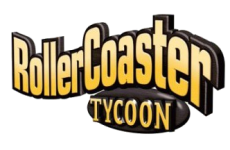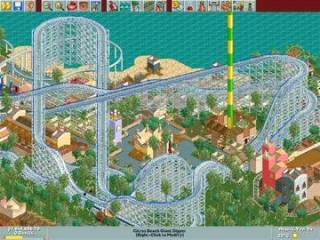Overview
From the mind of Chris Sawyer, the RollerCoaster Tycoon series simulates the construction and management of theme parks. The parks are arranged on an isometric grid that the player has full view of, allowing the player to modify their park's landscape, rides, scenery, etc. As time passes the player must work to keep the guests satisfied and entertained by expanding the park's selection of rides and ensuring it is well kept. The core of each game consists of a series of scenarios of varying difficulty that challenge players to meet certain goals, such as maintaining a highly rated park or attracting a number of guests. In later installments a sandbox mode was added, giving players free reign over a park without the encumbrance of a goal.

In order to create a thriving park the player must successfully manage all aspects of a theme park. While remaining under budget, utilizing the vast assortment of rides, food and service stalls, and scenery is key to creating a well-rounded park that keeps everyone happy. Other management necessities include hiring mechanics and janitors to make sure the park stays functional and clean. Failure to properly maintain and continually expand the park could mean a drop in park ratings, a decline in guests, or even crippling debt.
An array of true to life rides are at the player's disposal when constructing their park. From Ferris wheels to log rides, the player is able to create life-like parks that offer entertainment for anyone. The franchise is perhaps best known for its roller coaster creator, which gives players full control of the construction of their own custom roller coasters (as well as any other rides that consist of a track-design, like log flumes). The creator allows individual track pieces to be laid out, letting players choose the direction, slope, bank, and height of each one, as well as offering the player a variety of other roller coaster elements, such as vertical loops, corkscrews, and helices. Roller coasters can be tested to ensure they operate to the expectations of the player, and are given ratings to note how intense, entertaining, and vomit-inducing they are (non-coaster rides also have these ratings). These ratings are affected by calculated data for each coaster, including its average speed, number of drops, and the g-force exerted on the riders. Depending on a ride's ratings, it may be received well or poorly by guests, cause guests to become sick, or prove to be too intense for everyone but the most extreme roller coaster enthusiasts.
Games
RollerCoaster Tycoon
Released on March 31, 1999, the original RollerCoaster Tycoon was at first intended to be a sequel to Chris Sawyer's other hit simulation game Transport Tycoon. After Sawyer picked up a fascination for roller coasters, however, RollerCoaster Tycoon was born. Written almost entirely in assembly language, the original RollerCoaster Tycoon featured 22 scenarios, with a new one becoming unlocked after the completion of another. Each scenario is a new park with a new goal, some parks and rides being based on real life counterparts. The final scenario, Mega Park, has no other objective than to "Have Fun!", although is still not a true sandbox level due to a limited player budget. On March 25, 2003, an Xbox port was released and met with ambivalence, as it added nothing and changed very little.
Corkscrew Follies
Later that year on November 15, RollerCoaster Tycoon's first expansion pack, Corkscrew Follies (known as Added Attractions in Europe), was released. This pack added new roller coaster types and scenery (including the well-known banner sign) on top of the already large selection of the original game.
Loopy Landscapes
Loopy Landscapes includes the preceding expansion and adds even more rides and scenery, as well as new food/shop stalls, parks, and a whole new list of scenarios. Released September 30, 2000, 30 new scenarios were packed into this expansion, as well an abundance of new building options, which garnered this expansion much higher praise than Corkscrew Follies.
RollerCoaster Tycoon: Gold
This compilation, released in 2002, includes the original game and both the Corkscrew Follies and Loopy Landscapes expansions.
RollerCoaster Tycoon: Deluxe
This compilation, released in 2003, is the same as the Gold compilation, but with more pre-made designs of customizable rides.
RollerCoaster Tycoon 2
 Design unique roller coasters
Design unique roller coastersReleased October 15, 2002, RollerCoaster Tycoon 2 is the first sequel to the original. Although it was highly popular, the game was met with some criticism for being a near identical twin to its predecessor with new scenarios and a large ranger of riders, shops, and other building options. The gameplay itself was largely unchanged. Some new additions, however, earned high praise, such as the scenario editor for user-created scenarios and the more advanced tools for scenery placement. Licensed by Six Flags, the game also features five playable Six Flags theme parks. Also unlike its predecessor, most of the scenarios are unlocked from the beginning, and are divided into groups based on their difficulty. This would be the last RollerCoaster Tycoon game that Chris Sawyer would bet he lead designer on, though he would remain as a consultant for many of the forthcoming titles.
RollerCoaster Tycoon 2 Wacky Worlds
Released May 6 2003, Wacky Worlds is the first expansion to RollerCoaster Tycoon 2. This expansion added more scenarios and many new scenery and ride themes, inspired from locations around the world, such as London and Japan. It was met with some criticism because any "new" rides that were included were simply re-themed versions of already-included rides.
RollerCoaster Tycoon 2 Time Twister
Much like Wacky Worlds, Time Twister, released on August 15, 2003, added more scenarios and themes, yet was again criticized for the lack of gameplay changes and new rides. The themes of Time Twister were based on time periods in history, like the dark ages and the future.
RollerCoaster Tycoon 2: Combo Park Pack
This compilation, released in 2003, includes RollerCoaster Tycoon 2 and the Wacky Worlds expansion.
RollerCoaster Tycoon 2: Triple Thrill Pack
This compilation (also known as Totally RollerCoaster Tycoon 2), released in 2004, is the same as the Combo Park Pack, but also includes the Time Twister expansion.
RollerCoaster Tycoon 3
 Ride the rides
Ride the ridesRollerCoaster Tycoon 3, released October 26, 2004, makes a leap into 3D graphics for the first time in the franchise. With a now fully-rotational viewpoint (though there is an optional isometric viewpoint), players can see their park from any angle. Many new gameplay changes were introduced to the series as well, such as the CoasterCam, which allows players to ride their rides in first person view. Other new features include musically-coordinated fireworks shows, guests (now known as "peeps") of varying ages and gender, and the highly desired sandbox mode, which put players in charge of an empty park with no monetary, time, or goal restrictions. Similarly to the original RollerCoaster Tycoon, most of the scenarios are locked at the start, requiring players to complete unlocked scenarios before they are able to move on to the next. The game also improves sharing functionality between players, allowing them to easily import and export custom rides, scenarios, and scenery.
RollerCoaster Tycoon 3: Soaked!
Soaked!, released March 17, 2005, is the first expansion for RollerCoaster Tycoon 3. Along with new scenarios, it adds many water park features, such as swimming pools, water slides, aquariums, and other water features for players to create full water parks.
RollerCoaster Tycoon 3: Wild!
Released on November 4, 2005, the Wild! expansion lets players place animal exhibits and create zoos within their theme parks. As with previous expansions, new scenarios are also included, as well as new rides and building options.
RollerCoaster Tycoon 3: Gold
This compilation, released in 2005, includes RollerCoaster Tycoon 3 and the Soaked! expansion.
RollerCoaster Tycoon 3: Platinum
This compliation (also known as RollerCoaster Tycoon 3 Deluxe Edition), released in 2006, is the same as the Gold compilation, but also includes the Wild! expansion.
RollerCoaster Tycoon 3D
Released on October 16, 2012, RollerCoaster Tycoon 3D is the first mobile adaption of the RollerCoaster Tycoon franchise. Released on the Nintendo 3DS, the game is a limited version of RollerCoaster Tycoon 3 that also features a new "Coaster Story" mode, putting the player in the role of an aspiring young roller coaster designer.
Log in to comment